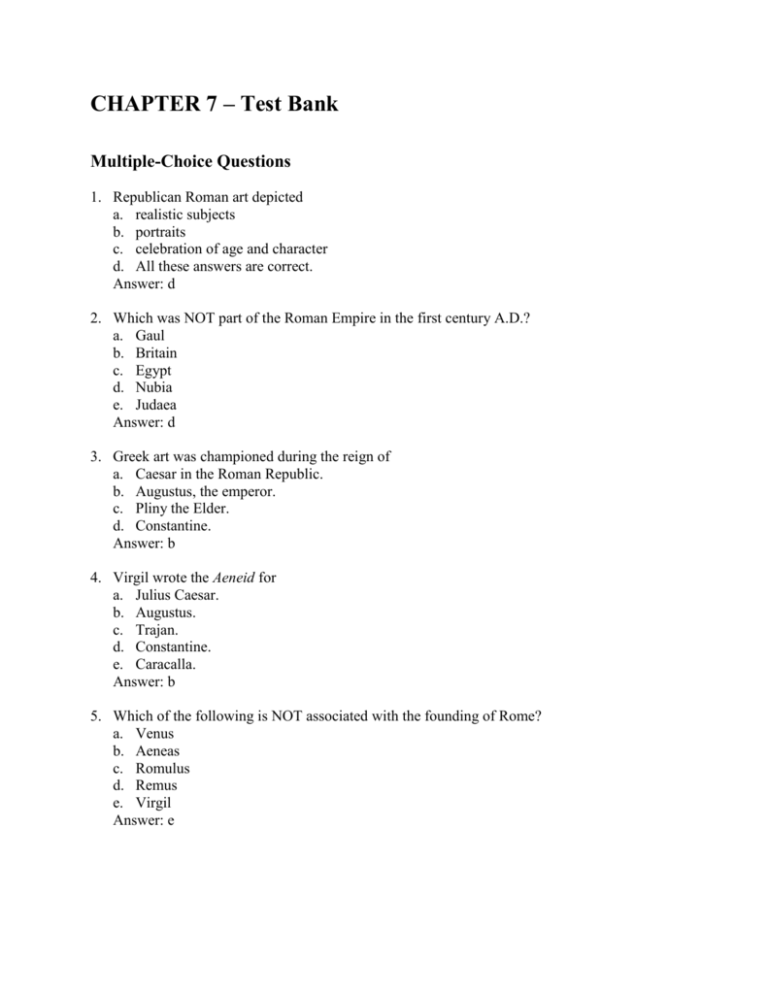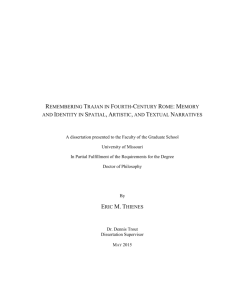Chapter 07 Test Bank
advertisement

CHAPTER 7 – Test Bank Multiple-Choice Questions 1. Republican Roman art depicted a. realistic subjects b. portraits c. celebration of age and character d. All these answers are correct. Answer: d 2. Which was NOT part of the Roman Empire in the first century A.D.? a. Gaul b. Britain c. Egypt d. Nubia e. Judaea Answer: d 3. Greek art was championed during the reign of a. Caesar in the Roman Republic. b. Augustus, the emperor. c. Pliny the Elder. d. Constantine. Answer: b 4. Virgil wrote the Aeneid for a. Julius Caesar. b. Augustus. c. Trajan. d. Constantine. e. Caracalla. Answer: b 5. Which of the following is NOT associated with the founding of Rome? a. Venus b. Aeneas c. Romulus d. Remus e. Virgil Answer: e 6. The Goths were a. Gauls. b. Dacians. c. Germans. d. Trojans. e. Greeks. Answer: c 7. Roman concrete was a mixture of a. water, tufa, travertine, and rubble. b. water, mortar, gravel, and rubble. c. stucco, plaster, water, mortar, and rubble. d. tufa, rubble, gravel, and mortar. Answer: b 8. Which was NOT a Roman architectural type? a. the private house b. the round temple c. the peripteral temple d. the circus e. the Colosseum Answer: c 9. Pompeii was destroyed a. in A.D. 79. b. in the first century B.C. c. under Nero. d. in A.D. 121. Answer: a 10. Pompeiian wall paintings of the Second Style are characterized by a. scenes like theater sets. b. painted inlaid stone. c. pictures showing paintings on the wall. d. illusionistic landscapes. Answer: d 11. Which of the following was NOT built under Trajan? a. Timgad b. Dacia c. markets d. a forum e. basilica Answer: b 12. Nero, as described by Suetonius, exemplifies a. political know-how. b. generosity. c. grandiosity. d. military strategy. Answer: c 13. Hadrian was especially influenced by a. Egyptian religion. b. Greek styles. c. Virgil’s Aeneid. d. Homer’s Iliad. e. Marcus Aurelius. Answer: b 14. The Golden House belonged to a. Suetonius. b. Caracalla. c. Constantine. d. Nero. e. Trajan. Answer: d 15. Which of the following is the best pairing? a. Virgil and Odysseus b. Ovid and the Metamorphoses c. Trajan and the Meditations d. Marcus Aurelius and the Commentarii Answer: b 16. The first known Roman forum dates from a. the 6th century B.C. b. the reign of Julius Caesar. c. the 1st century A.D. d. the reign of Augustus. Answer: a 17. The Ides of March is a. when Roman emperors are killed. b. the middle of the month. c. the birthday of the Roman emperor. d. the end of the month. e. the beginning of the month. Answer: b 18. Which was LEAST likely to be in a forum? a. temples b. libraries c. markets d. baths e. basilicas Answer: d 19. Two streets intersecting at right angles in ancient Roman cities were the a. castra and cardo. b. insula and decumanus. c. castra and decumanus. d. cardo and decumanus. Answer: d 20. The Pont du Gard at Nîmes was a. an aqueduct. b. a temple. c. a bridge. d. both a bridge and an aqueduct. Answer: d 21. Which of the following was NOT a use of the Roman basilica? a. commerce b. worship c. law courts d. administration Answer: b 22. In contrast to Greek temples, Roman temples usually were a. set on tall podiums. b. approached from a single side. c. pseudoperipteral. d. All these answers are correct. Answer: d 23. Which best describes the architectural features of the basilica? a. aisles, apses, nave, clerestory windows b. aisles, nave, clerestory windows, impluvium c. apses, nave, impluvium, aisles d. atrium, nave, apse, clerestory windows Answer: a 24. Which is LEAST likely to have been a feature of the Roman bath? a. a museum b. a tepidarium c. a swimming pool d. a ball court e. a market Answer: e 25. The columns of the Colosseum were arranged in the following order from the first to the third level: a. Doric, Corinthian, Ionic. b. Ionic, Doric, Corinthian. c. Doric, Ionic, Corinthian. d. Corinthian, Ionic, Doric. e. Corinthian, Doric, Ionic. Answer: c 26. The most impressive Roman buildings were faced with a. marble. b. tufa. c. concrete. d. terra-cotta. Answer: a 27. The Roman circus was used primarily for a. animal performances. b. libraries. c. gladiatorial contests. d. horse races. e. chariot races. Answer: e 28. The Colosseum was constructed during the reign of a. Nero. b. Trajan. c. Vespasian. d. Constantine. e. Caracalla. Answer: c 29. The Roman Colosseum was built around a core of a. concrete. b. brick. c. sandstone. d. iron. Answer: a 30. Which is true of Roman temples? a. They are peripteral. b. They have a front and a back porch. c. They have a double cella. d. They are pseudoperipteral. Answer: d 31. Which is NOT a feature of the Pantheon? a. an oculus b. a rectangular cella c. a rotunda d. a portico e. a curved entablature Answer: b 32. An oculus is a. the opening at the center of a dome. b. a mystical doorway in a temple. c. the portholes in a Roman galley. d. the window in the wall above the main level of a temple, which lets light in. Answer: a 33. Coffering a. helped expand interior space. b. lightened the weight of a dome or arch. c. enhanced the illusion of recession in the ceiling. d. both lightened the weight of a dome or arch, and enhanced the illusion of a recession in the ceiling. Answer: d 34. The Pantheon included a. barrel vaults and groin vaults. b. a central dome. c. an eight-sided room. d. All these answers are correct. Answer: d 35. Which is NOT a commemorative monument? a. Trajan’s Column b. the Arch of Titus c. the Ara Pacis d. Colosseum e. the Pantheon Answer: d 36. The Ara Pacis was constructed under a. Augustus. b. Julius Caesar. c. Trajan. d. Nero. e. Constantine. Answer: a 37. Trajan’s most famous monument was a. the Baths of Trajan. b. an Arch of Trajan. c. the Ara Pacis of Trajan. d. Trajan’s Column. Answer: d 38. The Column of Trajan is uniquely Roman because of a. its enormous height. b. its narrative frieze. c. its setting. d. its material. Answer: b 39. The reliefs of Trajan’s Column differ from Classical Greek reliefs in the a. use of a spiral frieze. b. realistic rather than idealized battle scene. c. emphasis on historical facts. d. All these answers are correct. Answer: d 40. Which is NOT a feature of Roman triumphal arches? a. relief sculptures b. an attic c. inscriptions d. the Composite Order e. a portico Answer: e 41. Which is NOT correct? a. Juno is the wife of Jupiter. b. Vulcan is the son of Juno. c. Diana is the daughter of Juno. d. Minerva is the daughter of Jupiter. e. Mercury is the god of speed. Answer: c 42. The Jewish Wars were chronicled by a. Josephus. b. Virgil. c. Suetonius. d. Julius Caesar. e. Ovid. Answer: a 43. Trajan’s purpose in declaring war on the Dacians was to obtain their a. territory. b. women. c. gold. d. works of sculpture. e. weapons. Answer: c 44. Which was NOT a Roman funerary practice? a. the use of cinerary urns b. the necropolis c. the sarcophagus d. burial in graves Answer: b 45. Apotheosis refers to a. deification. b. abdication. c. ascending to power. d. election to office. Answer: a 46. Marcus Aurelius was a. an emperor and poet. b. an emperor and Stoic philosopher. c. a poet and Platonic philosopher. d. Hadrian’s lover. e. an equestrian monument. Answer: b 47. The figures from the frieze of the Villa of the Mysteries are thought to depict an initiation into a. the cult of Artemis. b. Christianity. c. the cult of Bacchus. d. the cult of Isis and Osiris. Answer: c 48. Which is NOT true of the Villa of the Mysteries frescoes? a. They represent an initiation rite. b. They have erotic elements. c. They have a red background. d. The figures are naturalistic. e. They include details of landscape. Answer: e 49. The entry court of a Roman house was called the a. aquarium. b. atrium. c. bacterium. d. oculus. Answer: b 50. In the scene from the Odyssey Landscapes illustrated in this chapter, a. cannibals are depicted. b. Laestrygonians are depicted helping Odysseus’s men. c. there is no landscape detail. d. people are hunting animals. Answer: a 51. Young Woman with a Stylus is an example of a. a relief. b. a marble bust. c. a tondo. d. a second style fresco. Answer: c 52. Hercules is the son of a. Juno and Jupiter. b. Alkmene and Amphitryon. c. Juno and Amphitryon. d. Jupiter and Alkmene. Answer: d 53. Which is NOT a characteristic of Roman frescoes? a. They are fresco secco. b. They are often found in private houses. c. They are naturalistic. d. They contain shading, cast shadows, and oblique viewpoints. e. They contain the illusion of three-dimensional space. Answer: a 54. Faiyum painting was produced in a. Greece. b. Egypt. c. Rome. d. Nubia. e. Carthage. Answer: b 55. The portrait incorporated into the mummy case of Artemidoros a. is an ancestor portrait. b. is a fresco. c. is in encaustic. d. is a portrait bust. Answer: c 56. The Punic Wars were fought between a. Rome and Carthage. b. Rome and Greece. c. Rome and Phoenicia. d. Rome and Etruria. Answer: a 57. Dido was a. the deserted wife of Aeneas. b. the queen of Carthage. c. the queen of Faiyum. d. the heroine of Petrarch’s Africa. Answer: b 58. The Tophet refers to a. a Punic shrine. b. a temple. c. a site of child sacrifice. d. a site of ritual suicide. Answer: c 59. What action did Diocletian take in an attempt to restore order to the Roman Empire? a. move the imperial residence to Constantinople b. legalize Christianity c. liberalize Roman citizenship requirements d. establishe the tetrarchy Answer: d







